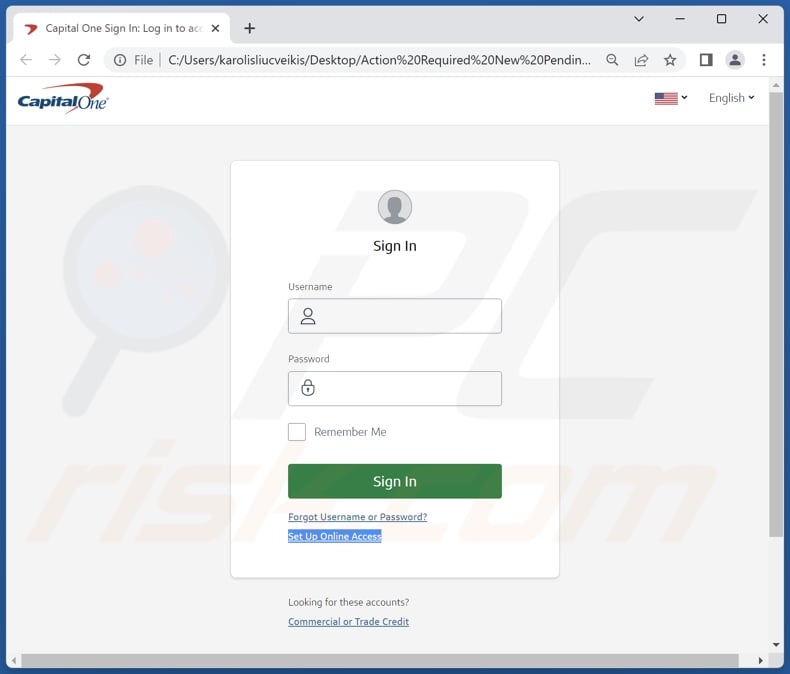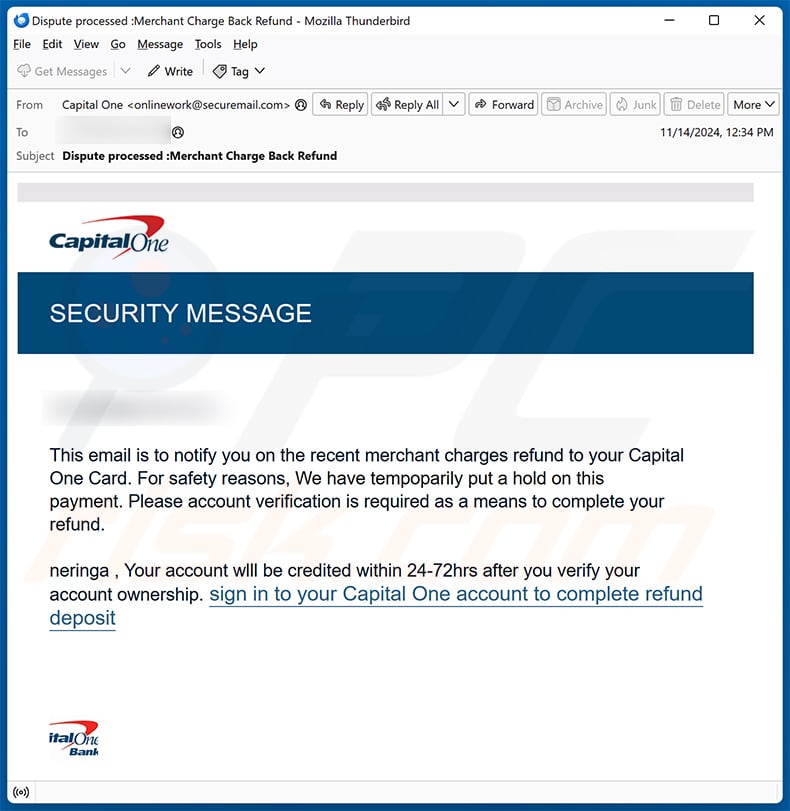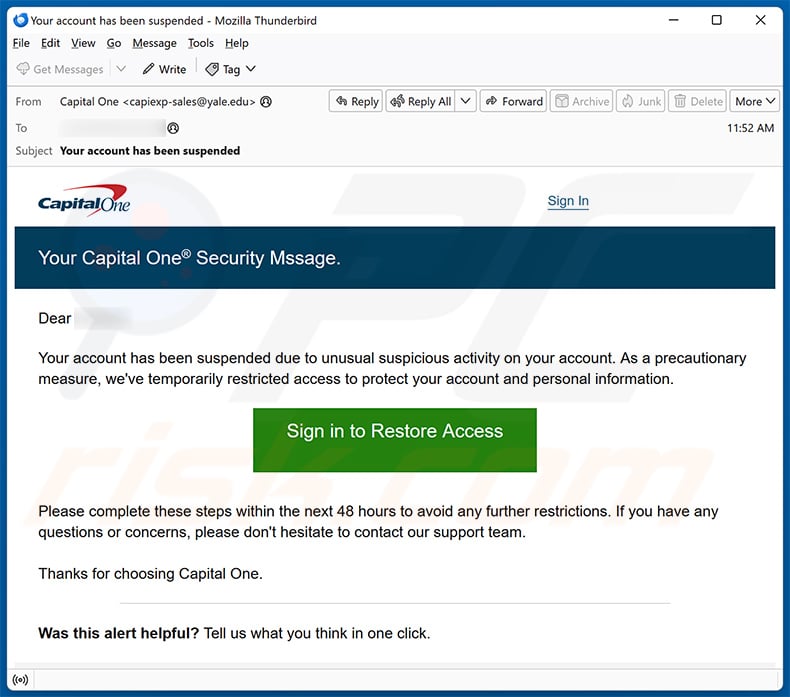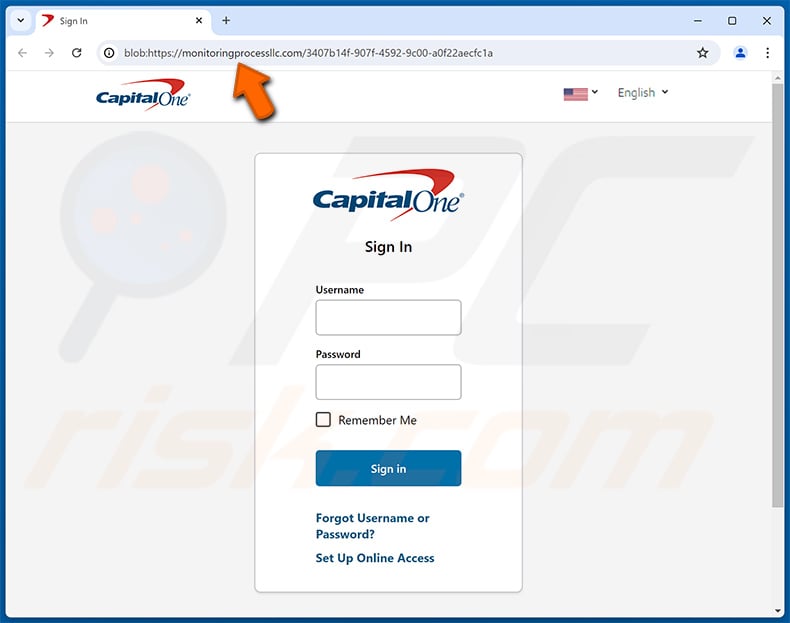Avoid having your Capital One account stolen via fake "SECURITY MESSAGE" emails
Phishing/ScamAlso Known As: "Capital One SECURITY MESSAGE" phishing email
Get free scan and check if your device is infected.
Remove it nowTo use full-featured product, you have to purchase a license for Combo Cleaner. Seven days free trial available. Combo Cleaner is owned and operated by RCS LT, the parent company of PCRisk.com.
What kind of email is "Capital One SECURITY MESSAGE"?
"Capital One SECURITY MESSAGE" is a phishing email. It is disguised as a notification from Capital One regarding an incoming payment to the recipient's account. Supposedly, the payment verification process requires them to sign in through an attached HTML document, which is a phishing file that records entered information.
It must be stressed that this fake email is in no way associated with the real Capital One bank holding company.

"Capital One SECURITY MESSAGE" email scam overview
The spam email with the subject "Action Required: New Pending E-payment on Your Account" (may vary) is presented as a "security message" from Capital One. The letter notifies that an incoming payment is pending on the recipient's account. To accept the payment, the recipient is instructed to download the "secure attachment" and verify their account ownership.
As mentioned in the introduction, all the information provided by this email is fake, and this mail is not associated with Capital One.
The attached HTML file ("Action Required New Pending E-payment on Your Account.html"; filename may vary) is disguised as the sign-in page for Capital One. Log-in credentials (i.e., usernames/passwords) entered into this file will be recorded and sent to the scammers behind this spam campaign.
Cyber criminals can carry out a variety of finance and identity related malicious activities via the stolen accounts. Victims of scam mail like "Capital One SECURITY MESSAGE" can experience severe privacy issues, significant financial losses, and even identity theft.
If you have already disclosed your log-in credentials – immediately change the passwords of all possibly exposed accounts and inform their official support. It might also be necessary to contact the appropriate authorities.
| Name | "Capital One SECURITY MESSAGE" phishing email |
| Threat Type | Phishing, Scam, Social Engineering, Fraud |
| Fake Claim | Recipient has an incoming payment to their Capital One account. |
| Disguise | Capital One |
| Attachment(s) | Action Required New Pending E-payment on Your Account.html (filename may vary) |
| Detection Names (attachment) |
N/A (VirusTotal) |
| Symptoms | Unauthorized online purchases, changed online account passwords, identity theft, illegal access of the computer. |
| Distribution methods | Deceptive emails, rogue online pop-up ads, search engine poisoning techniques, misspelled domains. |
| Damage | Loss of sensitive private information, monetary loss, identity theft. |
| Malware Removal (Windows) |
To eliminate possible malware infections, scan your computer with legitimate antivirus software. Our security researchers recommend using Combo Cleaner. Download Combo CleanerTo use full-featured product, you have to purchase a license for Combo Cleaner. 7 days free trial available. Combo Cleaner is owned and operated by RCS LT, the parent company of PCRisk.com. |
Phishing spam campaign examples
We have investigated countless spam emails; "Upcoming Auction", "OVHCloud Suspension", and "American Express Account Has Been Locked" are just a couple examples of ones used for phishing.
Various scams are facilitated through deceptive letters, and they are even used to proliferate malware. Spam can be plain, riddled with errors, or competently disguised as messages from genuine companies, organizations, institutions, service providers, authorities, and other entities.
Due to how widespread and potentially well-made spam mail can be – we highly recommend treating incoming emails, PMs/DMs, SMSes, and other messages with caution.
How do spam campaigns infect computers?
Spam emails can include malicious files as attachments or download links. They come in various formats, e.g., documents (PDF, Microsoft Office, Microsoft OneNote, etc.), archives (ZIP, RAR, etc.), executables (.exe, .run, etc.), JavaScript, and so forth.
When such a file is opened – the malware download/installation chain is triggered. However, some formats may require additional user interaction to start infection processes. To elaborate, Microsoft Office files need users to enable macro commands (i.e., editing/content), while OneNote documents require them to click on embedded files or links.
How to avoid installation of malware?
We strongly advise being vigilant with incoming emails and other messages. Attachments or links present in dubious mail must not be opened, as they can be malicious. We recommend using post-2010 Microsoft Office versions since they have the "Protected View" mode that prevents automatic macro execution.
It must be noted that malware is not distributed exclusively via spam mail. Therefore, we also advise being careful when browsing since fraudulent and dangerous online content usually appears legitimate and harmless.
Furthermore, all downloads must be performed from official and verified channels. Another recommendation is to activate and update programs by using functions/tools provided by genuine developers, as illegal activation tools ("cracks") and third-party updaters may contain malware.
We must stress the importance of having a dependable anti-virus installed and kept up-to-date. This software must be used to run regular system scans and to remove detected threats/issues. If you've already opened malicious attachments, we recommend running a scan with Combo Cleaner Antivirus for Windows to automatically eliminate infiltrated malware.
Text presented in the "Capital One SECURITY MESSAGE" spam email letter:
Subject: Action Required: New Pending E-payment on Your Account
CapitalOne
SECURITY MESSAGE
Dear Valuable Customer,
This email is to notify you that you have a new incoming payment pending on your account
For safety reasons, Please download secure attachment to review payment.
Update and verify your account ownership is required as a means to accept your payment.
Notice: Account wlll be credited within 24-72hrs after you verify your account ownership
Thank you for being a Capital One customer.
Screenshot of the phishing attachment ("Action Required New Pending E-payment on Your Account.html"):

Another example of an email from "Capital One SECURITY MESSAGE" spam campaign:

Text presented within:
Subject: Dispute processed :Merchant Charge Back Refund
Visit Capital One
SECURITY MESSAGE- ,
This email is to notify you on the recent merchant charges refund to your Capital One Card. For safety reasons, We have tempoparily put a hold on this payment. Please account verification is required as a means to complete your refund.
- , Your account wlll be credited within 24-72hrs after you verify your account ownership. sign in to your Capital One account to complete refund deposit
Capital One Symbol
Capital One Online Team
Another example of an email from "Capital One SECURITY MESSAGE" spam campaign:

Text presented within:
Subject: Your account has been suspended
Visit Capital One Sign In
Your Capital One® Security Mssage.
Dear -,
Your account has been suspended due to unusual suspicious activity on your account. As a precautionary measure, we've temporarily restricted access to protect your account and personal information.
Sign in to Restore Access
Please complete these steps within the next 48 hours to avoid any further restrictions. If you have any questions or concerns, please don't hesitate to contact our support team.
Thanks for choosing Capital One.
Screenshot of the promoted phishing site:

Instant automatic malware removal:
Manual threat removal might be a lengthy and complicated process that requires advanced IT skills. Combo Cleaner is a professional automatic malware removal tool that is recommended to get rid of malware. Download it by clicking the button below:
DOWNLOAD Combo CleanerBy downloading any software listed on this website you agree to our Privacy Policy and Terms of Use. To use full-featured product, you have to purchase a license for Combo Cleaner. 7 days free trial available. Combo Cleaner is owned and operated by RCS LT, the parent company of PCRisk.com.
Quick menu:
- What is "Capital One SECURITY MESSAGE" phishing email?
- Types of malicious emails.
- How to spot a malicious email?
- What to do if you fell for an email scam?
Types of malicious emails:
![]() Phishing Emails
Phishing Emails
Most commonly, cybercriminals use deceptive emails to trick Internet users into giving away their sensitive private information, for example, login information for various online services, email accounts, or online banking information.
Such attacks are called phishing. In a phishing attack, cybercriminals usually send an email message with some popular service logo (for example, Microsoft, DHL, Amazon, Netflix), create urgency (wrong shipping address, expired password, etc.), and place a link which they hope their potential victims will click on.
After clicking the link presented in such email message, victims are redirected to a fake website that looks identical or extremely similar to the original one. Victims are then asked to enter their password, credit card details, or some other information that gets stolen by cybercriminals.
![]() Emails with Malicious Attachments
Emails with Malicious Attachments
Another popular attack vector is email spam with malicious attachments that infect users' computers with malware. Malicious attachments usually carry trojans that are capable of stealing passwords, banking information, and other sensitive information.
In such attacks, cybercriminals' main goal is to trick their potential victims into opening an infected email attachment. To achieve this goal, email messages usually talk about recently received invoices, faxes, or voice messages.
If a potential victim falls for the lure and opens the attachment, their computers get infected, and cybercriminals can collect a lot of sensitive information.
While it's a more complicated method to steal personal information (spam filters and antivirus programs usually detect such attempts), if successful, cybercriminals can get a much wider array of data and can collect information for a long period of time.
![]() Sextortion Emails
Sextortion Emails
This is a type of phishing. In this case, users receive an email claiming that a cybercriminal could access the webcam of the potential victim and has a video recording of one's masturbation.
To get rid of the video, victims are asked to pay a ransom (usually using Bitcoin or another cryptocurrency). Nevertheless, all of these claims are false - users who receive such emails should ignore and delete them.
How to spot a malicious email?
While cyber criminals try to make their lure emails look trustworthy, here are some things that you should look for when trying to spot a phishing email:
- Check the sender's ("from") email address: Hover your mouse over the "from" address and check if it's legitimate. For example, if you received an email from Microsoft, be sure to check if the email address is @microsoft.com and not something suspicious like @m1crosoft.com, @microsfot.com, @account-security-noreply.com, etc.
- Check for generic greetings: If the greeting in the email is "Dear user", "Dear @youremail.com", "Dear valued customer", this should raise suspiciousness. Most commonly, companies call you by your name. Lack of this information could signal a phishing attempt.
- Check the links in the email: Hover your mouse over the link presented in the email, if the link that appears seems suspicious, don't click it. For example, if you received an email from Microsoft and the link in the email shows that it will go to firebasestorage.googleapis.com/v0... you shouldn't trust it. It's best not to click any links in the emails but to visit the company website that sent you the email in the first place.
- Don't blindly trust email attachments: Most commonly, legitimate companies will ask you to log in to their website and to view any documents there; if you received an email with an attachment, it's a good idea to scan it with an antivirus application. Infected email attachments are a common attack vector used by cybercriminals.
To minimise the risk of opening phishing and malicious emails we recommend using Combo Cleaner Antivirus for Windows.
Example of a spam email:

What to do if you fell for an email scam?
- If you clicked on a link in a phishing email and entered your password - be sure to change your password as soon as possible. Usually, cybercriminals collect stolen credentials and then sell them to other groups that use them for malicious purposes. If you change your password in a timely manner, there's a chance that criminals won't have enough time to do any damage.
- If you entered your credit card information - contact your bank as soon as possible and explain the situation. There's a good chance that you will need to cancel your compromised credit card and get a new one.
- If you see any signs of identity theft - you should immediately contact the Federal Trade Commission. This institution will collect information about your situation and create a personal recovery plan.
- If you opened a malicious attachment - your computer is probably infected, you should scan it with a reputable antivirus application. For this purpose, we recommend using Combo Cleaner Antivirus for Windows.
- Help other Internet users - report phishing emails to Anti-Phishing Working Group, FBI’s Internet Crime Complaint Center, National Fraud Information Center and U.S. Department of Justice.
Frequently Asked Questions (FAQ)
Why did I receive this email?
Spam emails are not personal. Cyber criminals distribute this mail by the thousand with the hopes that at least some recipients will fall for their scams.
I have provided my personal information when tricked by this spam email, what should I do?
If you have provided your account credentials – change the passwords of all possibly exposed accounts and inform their official support without delay. And if you have disclosed or believe that your other private data is at risk (e.g., ID card details, passport photos/scans, credit card numbers, etc.) – immediately contact the corresponding authorities.
I have read a spam email but didn't open the attachment, is my computer infected?
Reading an email is harmless. Devices are infected when malicious attachments or links are opened/clicked.
I have downloaded and opened a file attached to a spam email, is my computer infected?
Whether your device was infected depends on the file's purpose (i.e., phishing vs. malware download/installation), and it may be impacted by its format. Executables (.exe, .run, etc.) infect systems almost without fail once opened. While documents (.doc, .xls, .one, .pdf, etc.) may need additional actions (e.g., enabling macros, clicking embedded content, etc.) to begin malware download/installation processes.
Will Combo Cleaner remove malware infections present in email attachments?
Yes, Combo Cleaner is capable of detecting and eliminating practically all known malware infections. Note that running a complete system scan is essential since high-end malicious programs typically hide deep within systems.
Share:

Tomas Meskauskas
Expert security researcher, professional malware analyst
I am passionate about computer security and technology. I have an experience of over 10 years working in various companies related to computer technical issue solving and Internet security. I have been working as an author and editor for pcrisk.com since 2010. Follow me on Twitter and LinkedIn to stay informed about the latest online security threats.
PCrisk security portal is brought by a company RCS LT.
Joined forces of security researchers help educate computer users about the latest online security threats. More information about the company RCS LT.
Our malware removal guides are free. However, if you want to support us you can send us a donation.
DonatePCrisk security portal is brought by a company RCS LT.
Joined forces of security researchers help educate computer users about the latest online security threats. More information about the company RCS LT.
Our malware removal guides are free. However, if you want to support us you can send us a donation.
Donate
▼ Show Discussion